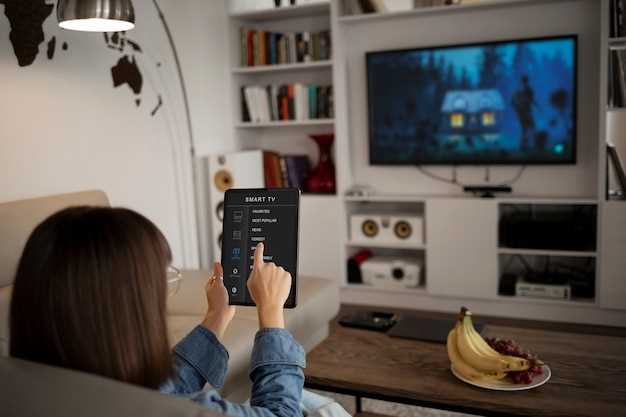
Streaming media has transformed the way we consume entertainment, offering a vast array of content accessible at our fingertips. Media consoles, often referred to as “streaming devices”, have further enhanced this experience, enabling seamless playback on televisions and other display devices. However, the convenience of streaming comes with a potential pitfall–data consumption. Understanding and managing data usage is crucial for ensuring an uninterrupted and cost-effective streaming experience.
This comprehensive guide will delve into the intricacies of data usage on media consoles. We will explore the factors that influence data consumption, provide practical tips for minimizing usage, and offer strategies for optimizing your streaming experience without sacrificing content quality. By following these guidelines, you can maximize the enjoyment of your streaming devices while minimizing data consumption and potential expenses.
Configure Network Settings for Optimal Usage
Table of Contents
To optimize usage, adjust network settings. Firstly, consider the connection type. A wired Ethernet connection offers higher stability and speed, especially for streaming and gaming.
Use Data-Saving Apps to Restrict Data Use
One effective way to curb excessive data consumption is to employ data-saving applications. These specialized tools monitor and regulate background processes, limiting their access to data. By leveraging these apps, users can proactively minimize unneeded data expenditure.
| App Feature | Data-Saving Benefit |
|---|---|
| Background data restriction | Prevents apps from consuming data in the background |
| Data usage monitoring | Provides insights into app-specific data usage |
| Data usage alerts | Notifies users when approaching data limits |
Stream Content in Lower Resolutions
The resolution of your video stream has a significant impact on your data consumption. Streaming in higher resolutions requires more bandwidth, which can quickly deplete your data allowance. Fortunately, most streaming services give you the option of adjusting the resolution of your stream. By choosing a lower resolution, you can significantly reduce your data usage.
The table below shows the approximate data usage per hour of streaming video at different resolutions:
| Resolution | Data Usage (GB) |
|---|---|
| 480p | 0.7 |
| 720p | 1.5 |
| 1080p | 3 |
| 4K | 7.5 |
As you can see, streaming in 480p uses significantly less data than streaming in 4K. If you’re on a limited data plan, it’s recommended to stick to lower resolutions for streaming.
Disable Background Data Refresh

To effectively manage your Android TV’s data consumption, consider deactivating the automatic background data refresh feature. This function allows apps to refresh their content even when the device is not actively in use, leading to potential data waste.
| Steps to Disable Background Data Refresh: |
|---|
| 1: Navigate to your device’s Settings. |
| 2: Select the “Network & Internet” option. |
| 3: Choose “Data Usage” or “Network Usage.” |
| 4: Locate the “Background Data” or “Restrict Background Data” setting and toggle it to ‘Off’. |
Limit Device Screen Time
Excessive screen time can impact data consumption and limit your device’s optimal performance. To minimize usage, consider implementing the following strategies. Set screen time limits: Establish daily or weekly limits for device use, including specific time slots for apps and browsing. Monitor screen time: Use built-in features or third-party apps to track your device usage and identify areas where adjustments can be made. Take screen breaks: Schedule regular breaks away from your device to prevent extended periods of inactivity that contribute to excessive data consumption. Explore alternative activities: Engage in non-digital activities like reading, writing, or spending time in nature to reduce device dependency and conserve data.
Use External Storage Devices to Reduce Streaming
Consider using external storage devices like USB drives or SD cards to store your media content. By transferring your movies, TV shows, and music to an external source, you can significantly reduce the amount of data you stream over the internet, especially if you have a limited data plan.
Utilize Wi-Fi Instead of Cellular Data
To effectively reduce the strain on your mobile data allowance, a strategic approach is to leverage Wi-Fi connectivity whenever feasible. Wi-Fi networks, typically available in homes, public spaces, and various establishments, provide a stable and high-speed internet connection without incurring cellular charges. By connecting your internet-enabled devices, including your Android TV Box, to a Wi-Fi network instead of relying solely on cellular data, you can significantly curtail your overall data consumption and avoid potential overage fees.
Monitor Data Usage Regularly
Keeping tabs on your internet consumption is vital in preventing unexpected data charges. Regularly reviewing your data usage allows you to identify any excessive activity or applications draining your bandwidth. Monitoring usage also helps you make informed decisions about your internet plan and consumption habits.
Connect to a Data-Capped Network
If you are connecting your device to a network with a data cap, it is important to be aware of your data usage to avoid exceeding the limit. There are several things you can do to minimize your data consumption when using your device.
One of the best ways to reduce your data usage is to connect to a Wi-Fi network when possible. Wi-Fi networks do not count towards your data cap, so you can use them to stream videos, play games, and browse the internet without worrying about using up your data. You can find free Wi-Fi networks at libraries, coffee shops, and other public places.
If you are using a cellular network, there are several settings you can adjust to reduce your data usage. You can disable background data usage for apps that you don’t need to be running all the time. You can also set a data limit for your device so that it will automatically stop using data when you reach a certain point.
| Tip | How to |
|---|---|
| Connect to Wi-Fi | Look for available Wi-Fi networks in your area and connect to one. |
| Disable background data usage | Go to Settings > Data usage > Background data and disable it for apps you don’t need running in the background. |
| Set a data limit | Go to Settings > Data usage > Data limit and set a limit for your data usage. |
Consider a Third-Party Data Management Tool
Enhancing your data monitoring and management capabilities could be achieved through the implementation of specialized software. These tools often provide comprehensive dashboards, granular reporting, and customizable alerts to help users gain a deeper understanding of data usage patterns, identify anomalies, and implement proactive measures to minimize unnecessary consumption.
Here’s a tabular comparison of some popular third-party data management tools:
| Tool | Features | Pricing |
|---|---|---|
| GlassWire | Real-time monitoring, app-level data tracking, intrusion detection | Free, Premium ($49/year) |
| NetWorx | Bandwidth monitoring, traffic analysis, threshold alerts | $29.95 |
| DU Meter | Unlimited data logs, custom reports, diagnostic tools | $24.95 |
Q&A
What is Android TV Box data usage?
Android TV Box data usage refers to the amount of internet data consumed by your Android TV Box while performing various activities such as streaming videos, playing games, using apps, or downloading content. It’s important to monitor your data usage to avoid exceeding your internet plan’s data limits and incurring additional charges.
How do I know if I’m using too much Android TV Box data?
To determine if you’re using too much Android TV Box data, you can check your data usage statistics in your device’s settings. If you notice a significant increase in data consumption or are consistently reaching your data limit, it’s a good indication that you need to take steps to minimize your usage.
 New mods for android everyday
New mods for android everyday



